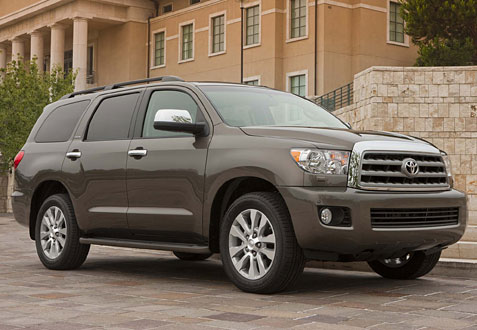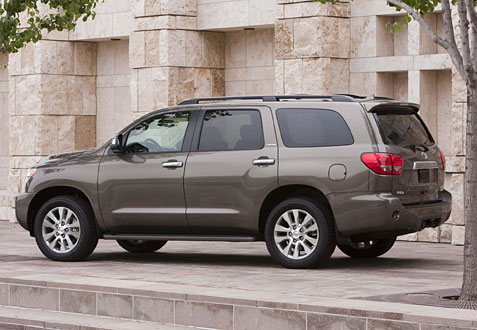Car Review: 2013 Toyota Sequoia

The 2013 Sequoia has made a statement of power, with all models for 2013 now boasting the 381-hp 5.7-liter V8 as standard. We had the opportunity to test drive this beast of a SUV for a week and have grown accustomed to this power trip.
There is certainly no mistaking the super white 2013 Toyota Sequoia on the open road. The Sequoia’s 0.36 drag coefficient (Cd) is comparable to smaller crossover-type vehicles. The vehicle’s mirrors, wipers, A-pillars and roof header are shaped to help maximize aerodynamic efficiency and minimize wind noise. Vehicle underside airflow is optimized to reduce drag and wind noise and to help improve directional control.
Headlamp washers are standard on all grades for improved visibility. The wide rear door-opening angle provides easy passenger ingress/egress and child seat installation. Our test model also included power heated outside mirrors, multi reflector halogen headlights with auto-off feature, fog lamps, tilt slide moon roof with sunshade, roof rack, rear spoiler, privacy glass, 18-inch alloy wheels and running boards. Yes, those running boards are worth every penny, as getting inside of the Sequoia is no joke!
The Sequoia dash features a finish similar to that in fine luxury cars. Each of Sequoia’s eight seating positions provides space sufficient to comfortably accommodate people well above normal height. The same efficient packaging that allows exceptional interior comfort also allows carrying items up to 11 feet long. Folding the second- and third-row seats flat opens the cargo area to 120.1 cubic feet of carrying capacity.
The second-row bench-type seat is split 40:20:40 and is equipped with a seat-slide mechanism that offers an adjustment range of 5.9 inches. This seat can also be folded flat and uses a one-touch easy-slide action to allow passenger access to the third-row seat. Second-row captain seats are available for a seven-seat cabin. The third-row seat is split 60:40, has a seatback reclining mechanism and can be easily folded flat. A power tilting and folding mechanism is available. The rear lift gate sliding glass can be opened and closed for easy loading with the turn of a key. The cargo area is equipped with handy hooks for grocery bags. Sequoia provides 16 extra-large cup/bottle holders (18 on the Platinum grade), as well as convenient storage spaces.
Nothing fancy inside the cabin that we appreciated on the Sequoia, as there is really no wasted space or fluff items that go unused. There are times that you just might think you are riding in a full-size pickup rather than an SUV with the feel of the interior. Some of the features that we really liked were the auto three-zone climate control with air filter, AM/FM CD 8-speaker stereo with XM radio, Aux, USB with iPod Bluetooth connectivity, power windows, keyless entry, cruise control, heated 10-way power adjusted driver seat, 6.1-inch high resolution touchscreen with split-screen capability and integrated backup camera display, navigation with Entune and leather trimmed seats.
Toyota Entune is very engaging, with mobile apps such as Bing, iHeartRadio, MovieTickets.com, OpenTable and Pandora, and real-time info on things like traffic, weather, fuel prices, sports and stocks.

There was not a single time while driving the 2013 Toyota Sequoia when we longed for more power. The standard engine for all 2013 Sequoia models is now the iForce DOHC 5.7-liter V8, teamed to a six-speed electronically controlled automatic transmission. The 5.7-liter engine produces 381 hp at 5,600 RPM and 401 lb.-ft. of torque at 3,600 RPM. The engine is equipped with dual independent Variable Valve Timing with intelligence (VVT-i). An Acoustic Control Induction System (ACIS) switches the intake tract length in two stages, based on engine RPM and throttle angle, to optimize torque across the engine speed range. Toyota specifies regular-grade fuel for the Sequoia.
The 5.7-liter V8 enables the Sequoia to tow up to 7,400 lbs., depending on model grade and equipment. Crucial for customers who tow, the 5.7-liter V8 produces 90 percent of its peak torque at just 2,200 rpm. A Tow/Haul mode modifies transmission shift points for optimal performance.
The standard Trailer Sway Control system uses the Vehicle Stability Control (VSC) to help counteract handling forces acting on the SUV in an effort to minimize the impact of trailer sway. The Sequoia’s towing hitch is integrated into the frame as a single unit. Toyota’s flexible torque converter lock-up control enhances efficiency in the six-speed automatic transmission, with lock-up occurring in fourth, fifth and sixth gears. The available Multi-Mode four-wheel-drive system uses a two-speed transfer case with a lockable TORSEN limited-slip center differential to power the front and rear wheels. The transfer case is shifted electronically via a rotary knob, and it locks with the push of a button. The four-wheel independent suspension uses upper and lower A-arms and coil springs at each wheel. The 38-foot turning circle is one of the tightest in Sequoia’s class. Sequoia uses 13.9-inch ventilated front disc brakes and 13.6-inch ventilated rear disc brakes. Four opposed pistons – two per side – ensure optimal braking performance and fade resistance.
When you look at the full-size SUV market, the choices are few and most aren’t as “true” as the Toyota Sequoia. Our test model was well-equipped with a sticker price of $51,498, which is in the heart of this segment. Fuel economy is what we expected from a huge vehicle like the Sequoia, coming in at 13mpg in the city and 17mpg in highway driving. If you want a full-size SUV that is built on performance, then the Sequoia might be the right choice for you with the standard 5.7 liter V8 and engine noise that one might associate more with a pickup truck rather than a SUV. We were okay with that, as this is a workhorse vehicle that is for customers who value a truck-based SUV and know they can tow just about anything they choose.
Related Posts
Comments Off on Car Review: 2013 Toyota Sequoia
Posted in: Car Reviews, Cars
Tags: Toyota, Toyota Sequoia, Toyota SUV







